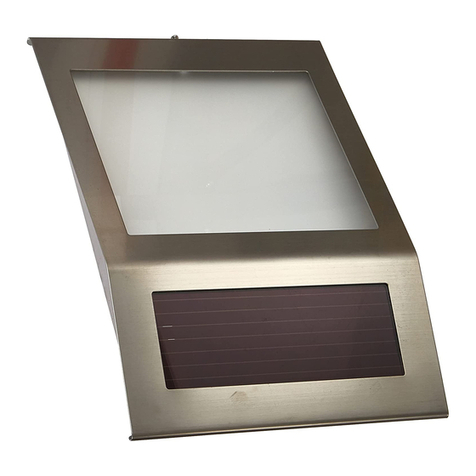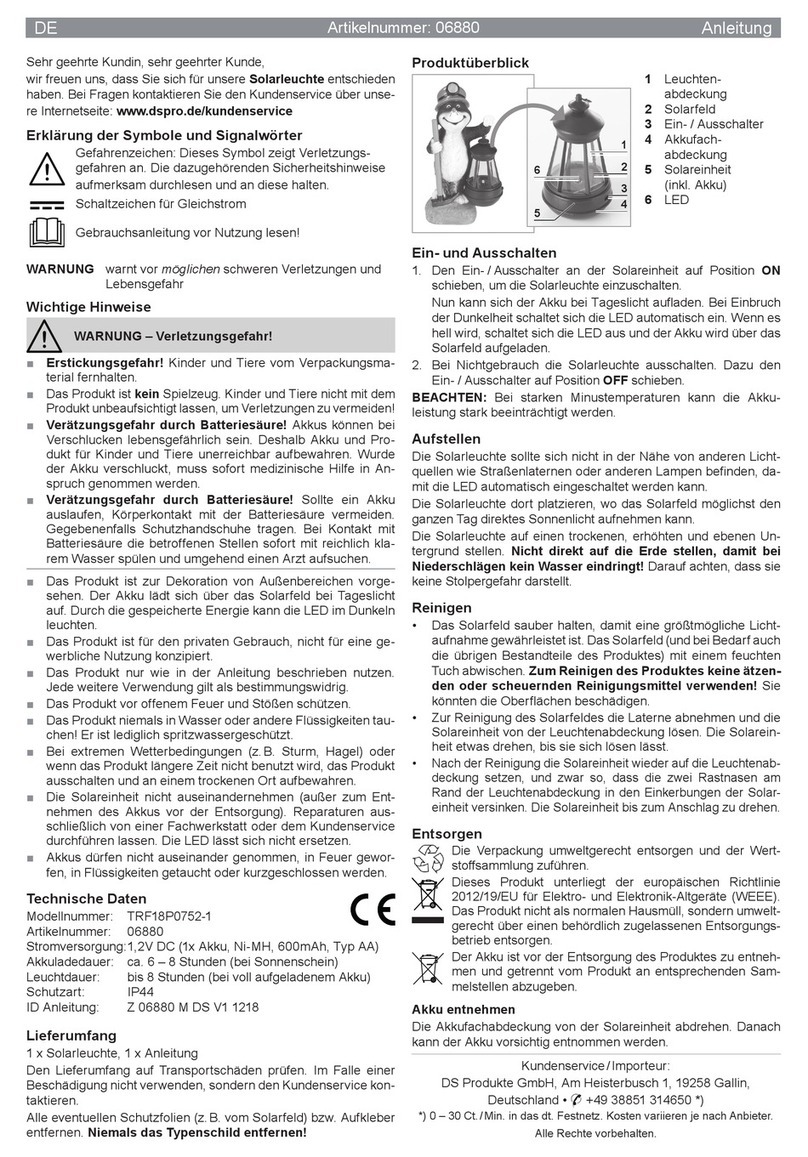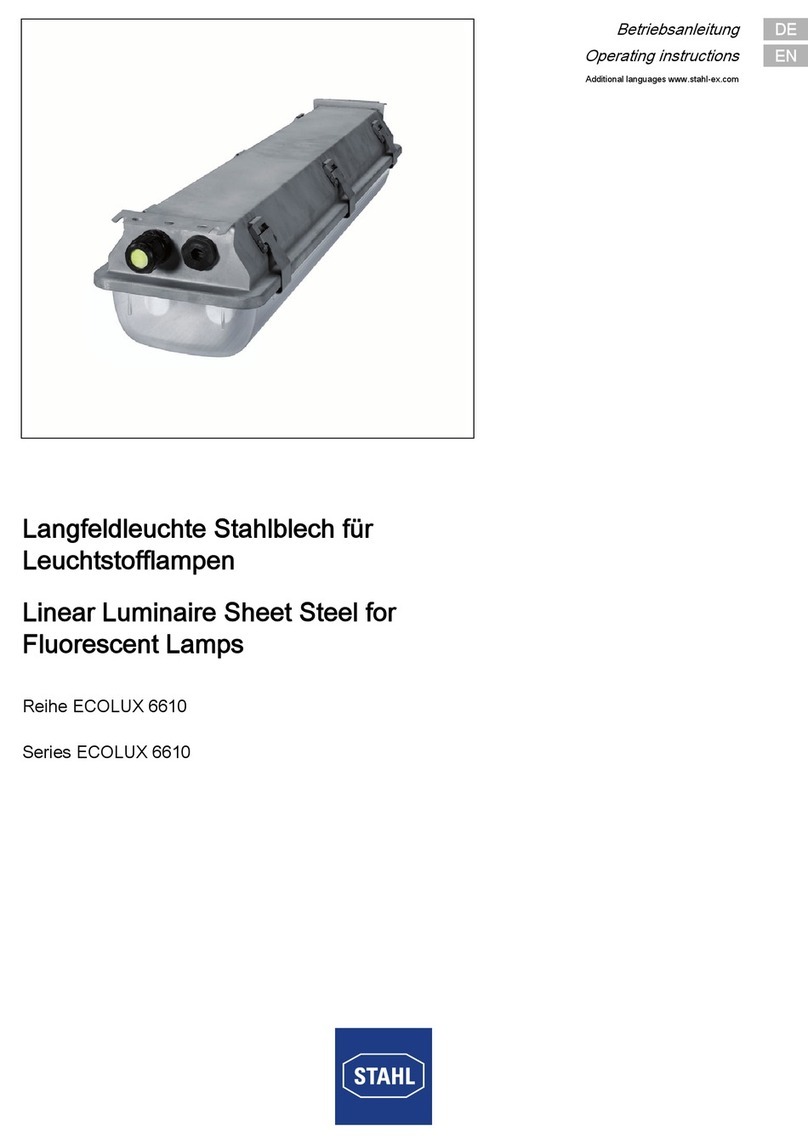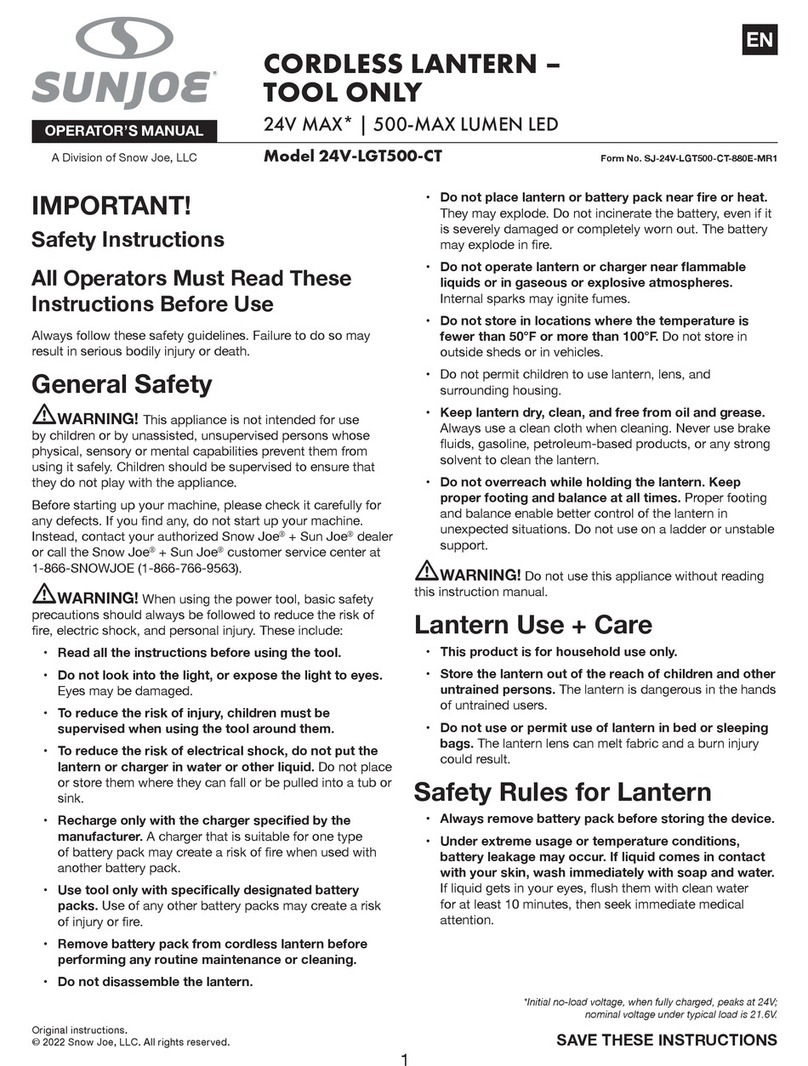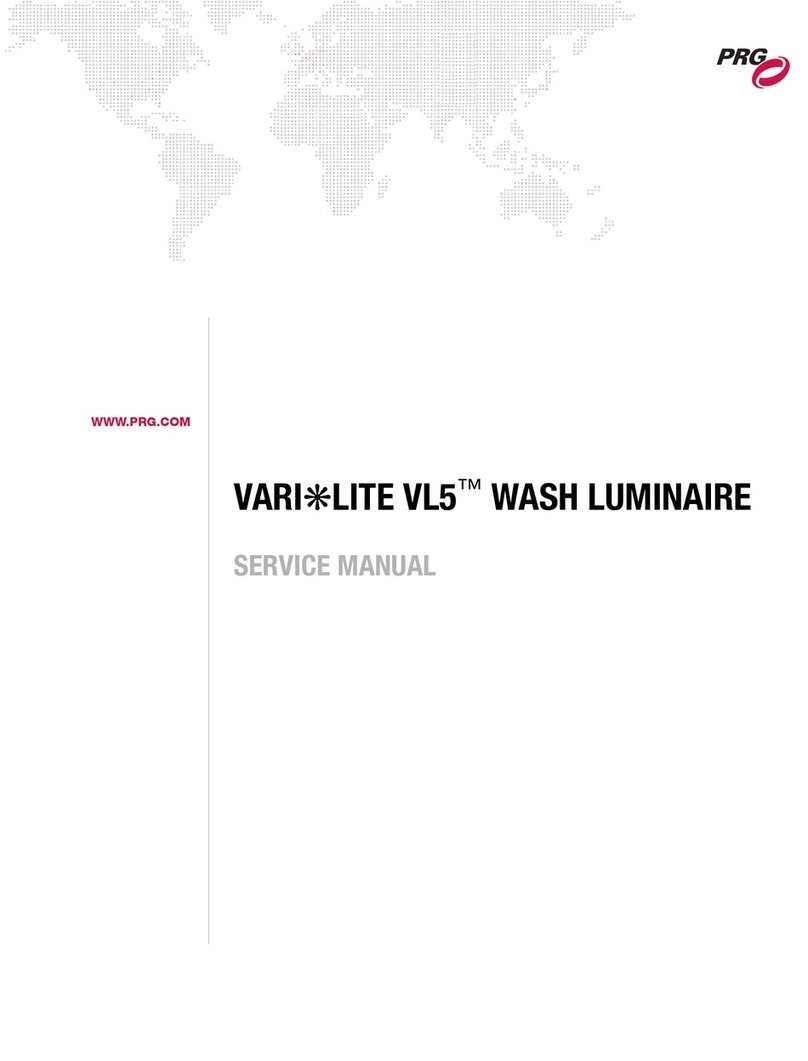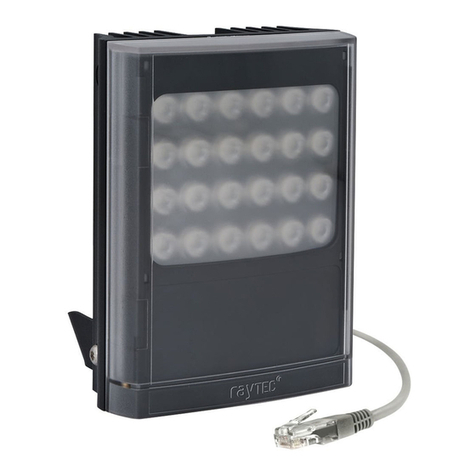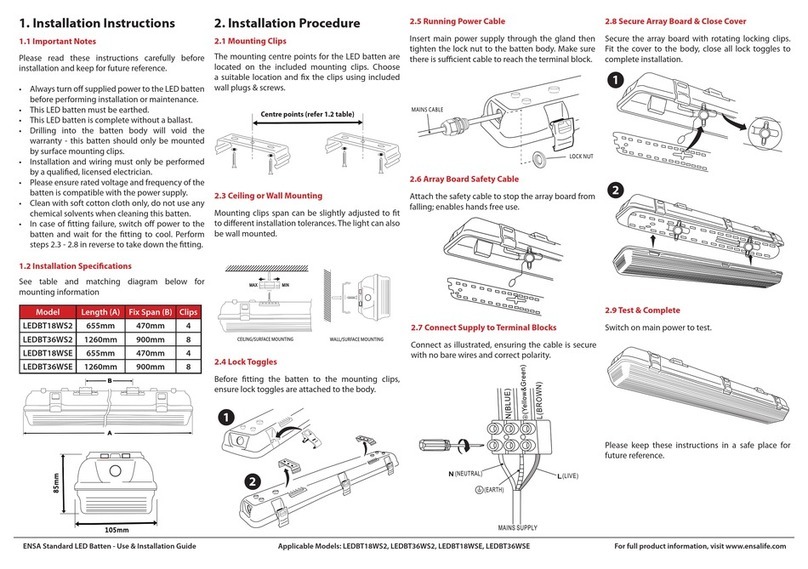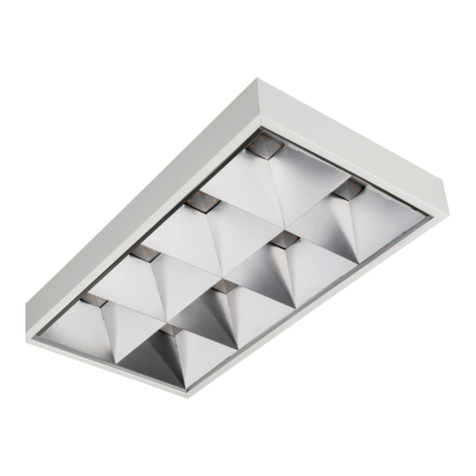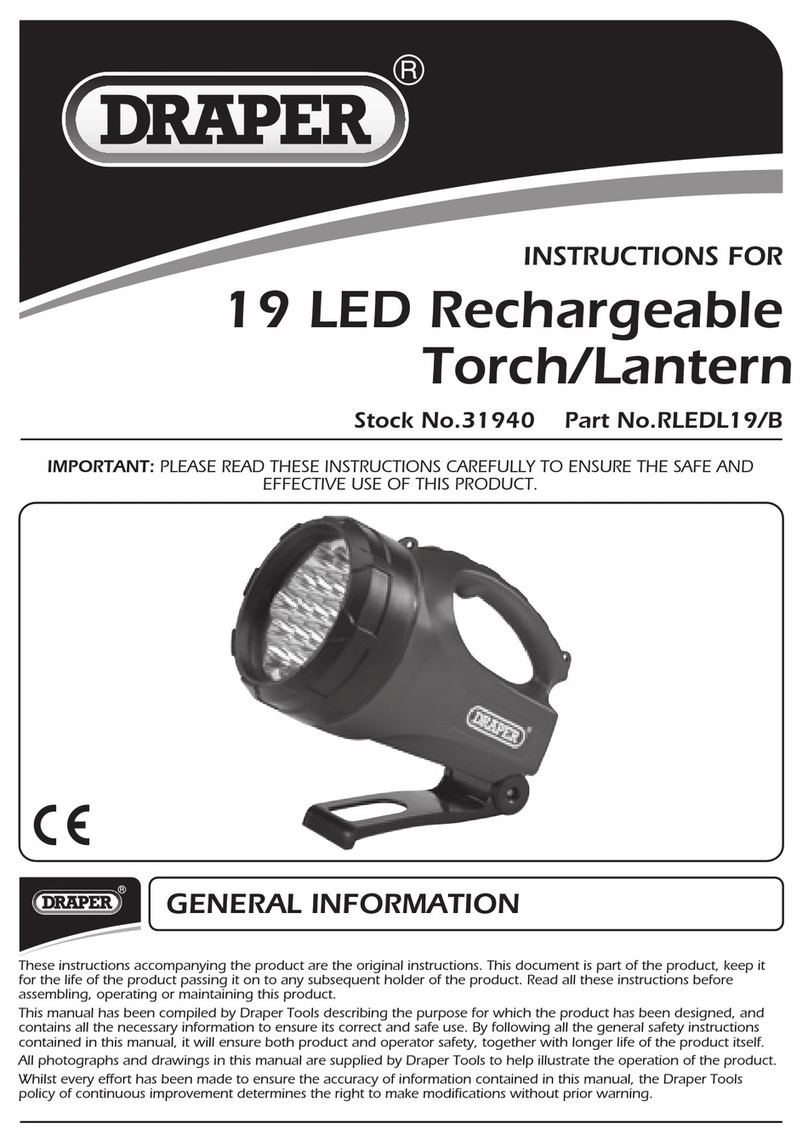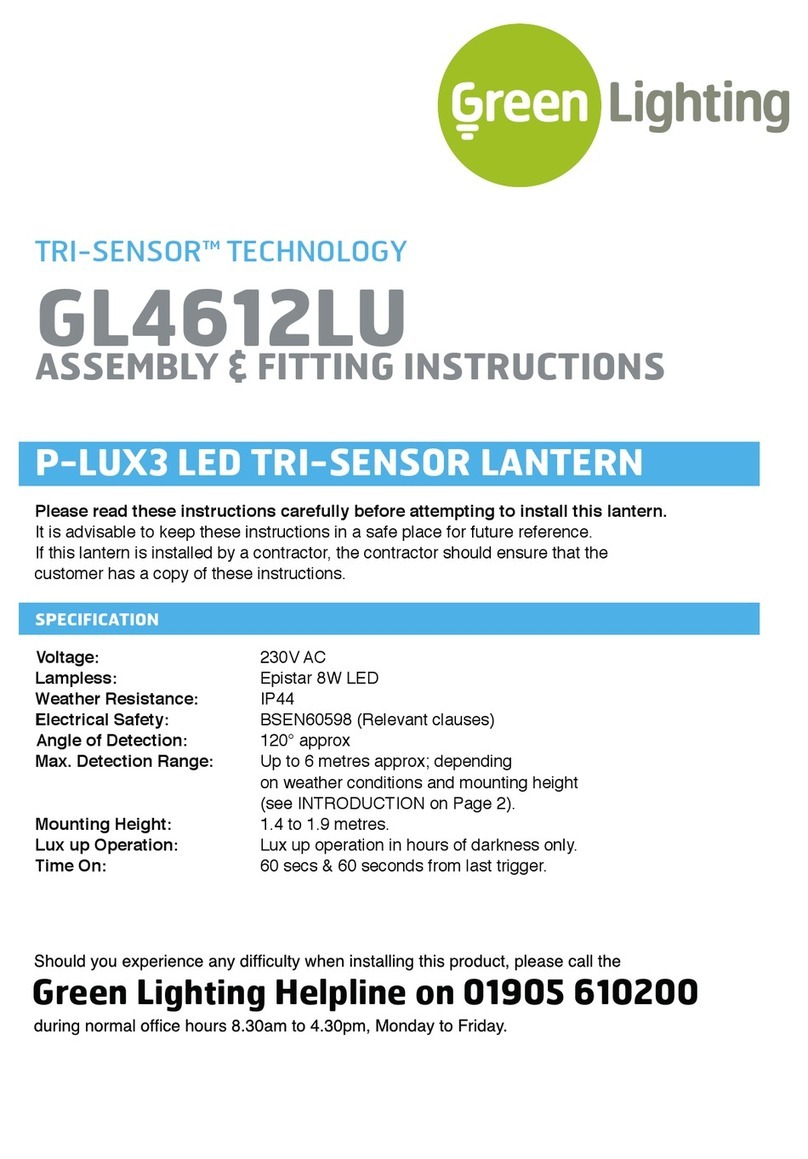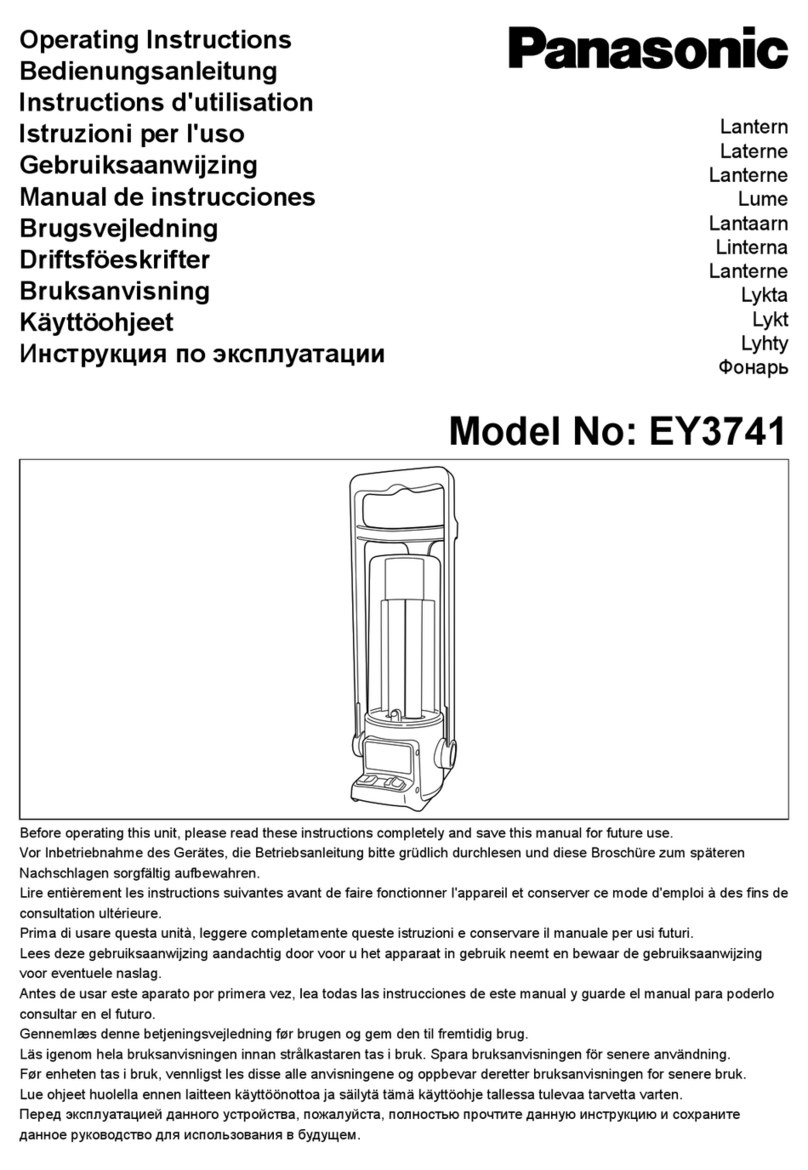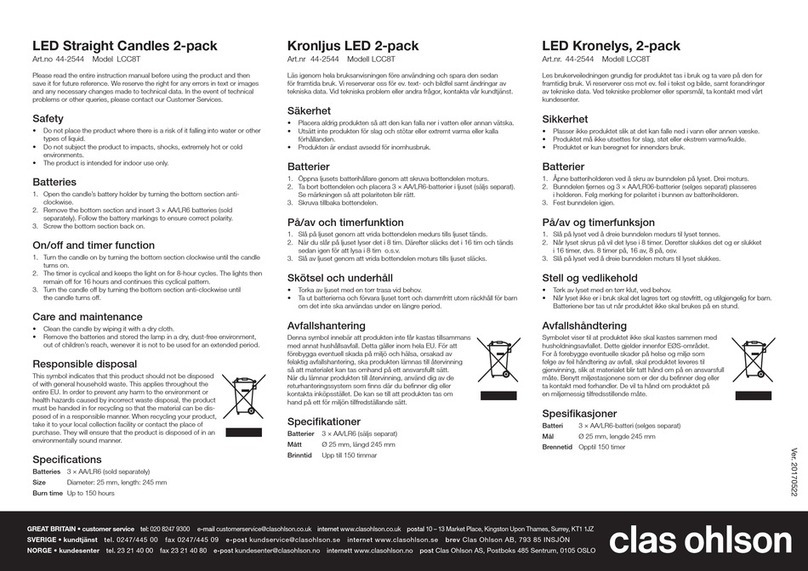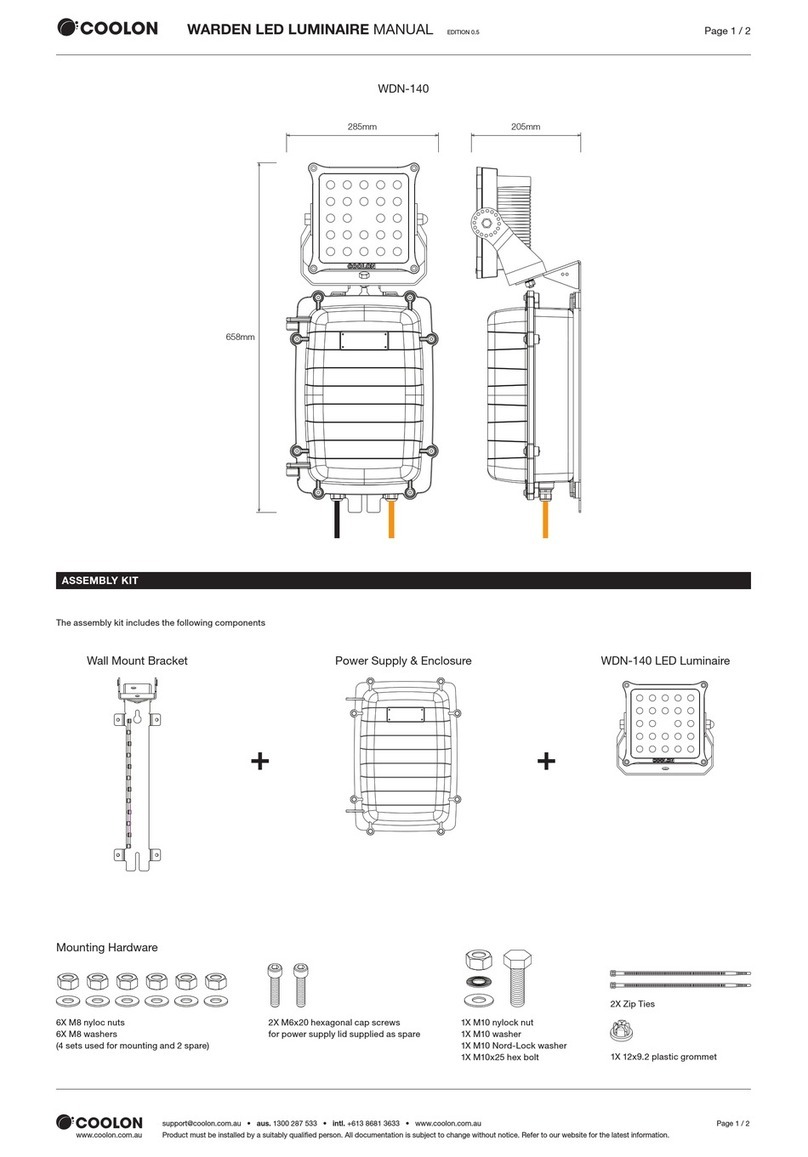GEV LPH 11014 User manual

08/2014 UW
MA00130903
Max. 14 Ct./Min aus dem deutschen Festnetz.
Mobil max. 42 Ct./Min.
International calls may vary.
Gutkes GmbH
Rehkamp 13
30853 Langenhagen
Germany
www.gev.de
service@gev.de
Hotline: +49 (0)180/59 58 555
www.gev.de
Typ: LPH
#011014
M
o
d
e
r
n
s
t
e
L
E
D
-
T
e
c
h
n
i
k
v
o
n
G
E
V

A
1
Akku-Pack
B
Akku-Pack
Akku-Pack
2
C
Akku-Pack
D
MIN. MIN.
MAX.
MIN. MIN.
32

54
Technische Daten
Leuchtmittel 1 weiße, wartungsfreie Leuchtdiode (LED)
Solar Modul Leistungsstarkes kristallines 1,4 W Solarmodul
Leuchtdauer max. 50 Stunden bei vollgeladenem Akku-Pack
Akku-Pack 1 x NiMh 3,6 V/1300 mAh
Gehäuse Edelstahl, gebürstet und lackiert
Abmessungen ca. B 240 x H 340 x T 40 mm
Fehleranalyse – Praktische Tipps
Störung Ursache Abhilfe
LED leuchtet nicht •Umgebungzuhell •Prüfenobexterne
Lichtquellen stören
(Straßenbeleuchtung etc.),
Position der Leuchte ändern.
LED leuchtet nicht •Akkusnichtgeladen,defekt •Akkusüberprüfen,austauschen
Schwache Lichtstärke •Akkusschwach •AkkusmitexternemLadegerät
aufladen/Akkus tauschen
Solar-Edelstahl-Hausnummernleuchte
LPH 11014
Mit dem Kauf dieses Artikels haben Sie
sich für ein qualitativ hochwertiges GEV
Produkt entschieden. Bitte lesen Sie diese
Bedienungsanleitung sorgfältig durch, um ein
einwandfreies Funktionieren zu gewährleisten.
Bewahren Sie diese Anleitung sorgfältig
auf, um gegebenenfalls später nachlesen zu
können.
Bestimmungsgemäße Verwendung
Die Solar-Hausnummernleuchte ist
für den Außenbereich entwickelt
worden. Das im oberen Teil eingebaute
Solarmodul (Abb. A1) wandelt
auftreendes Sonnenlicht in elektrischen Strom
um. Diese gewonnene Energie wird in den
eingebauten Akkus gespeichert. Bei Dämmerung/
Dunkelheit schaltet sich die Leuchte automatisch
ein und bei Helligkeit wieder aus.
Sicherheitshinweise
Bei Schäden, die durch Nichtbeachtung
dieser Bedienungsanleitung verursacht
werden, erlischt der Garantieanspruch!
Für Folgeschäden übernehmen wir
keine Haftung!
Bei Sach- oder Personenschäden, die durch
unsachgemäßeHandhabungoderNichtbeachtung
der Sicherheitshinweise verursacht werden,
übernehmen wir keine Haftung. In solchen Fällen
erlischt jeder Garantieanspruch. Aus Sicherheits-
und Zulassungsgründen ist das eigenmächtige
Umbauen und/oder Verändern des Gerätes nicht
gestattet.
Wenn Sie sich bei Montage, Anschluss oder
Installation nicht sicher sind, bzw. Zweifel über
die Funktionsweise bestehen, so nehmen Sie
Montage/Anschluss/Installation nicht selber vor,
sondern wenden Sie sich an eine Fachkraft.
Erstmalige Verwendung/Akkus laden
Die Solar- Hausnummernleuchte darf nur mit
NiMh Akkus betrieben werden!
Verwenden Sie niemals herkömmliche
Batterien!
Vor der erstmaligen Verwendung oder nach einem
Tausch der Akkus müssen diese geladen werden!
Laden Sie die Akkus mit einem handelsüblichen
Ladegerät für NiMh Akkus vollständig auf. Die
Ladezeit ist abhängig von der Kapazität der
Akkus und dem Ladegerät.
Alternativ können die Akkus durch die
Solarzellen geladen werden, indem Sie die Solar-
Hausnummernleuchte draußen in die direkte
Sonne legen.
Lösen Sie die Befestigungsschraube (Abb. B2)
vom Vorderteil und nehmen es ab. Setzen Sie den
geladenen Akku-Pack ein. Vorderteil erst nach
Montage der Grundplatte wieder aufsetzen!
Besondere Beachtung bei Solarleuchten
Reduzierung der Leuchtdauer der LED:
Schattige Plätze verkürzen die Ladedauer der
Akkus.
Die Sonnenscheindauer ist im Winter geringer als
im Sommerhalbjahr.
Schmutz, Laub, Schnee auf den Solarzellen
reduzieren den Ladestrom.
Kalte Temperaturen vermindern die Leistung der
Akkus.
Montage
Lösen Sie die Befestigungsschraube (Abb. B2)
vom Vorderteil und nehmen es ab. Setzen Sie den
geladenen Akku-Pack ein. Vorderteil erst nach
Montage der Grundplatte wieder aufsetzen!
Die gewünschte Hausnummer vor der
Montage anbringen. Um eine lange Haftung
zu gewährleisten Untergrund vorher reinigen
(keine scharfen Reinigungsmittel verwenden).
Grundplatte mit den 3 beiliegenden Schrauben/
Dübeln montieren (Abb. B). Stecken Sie den
Stecker des Akku-Pack in die Buchse der
Solar-Hausnummernleuchte (Abb. C). Vorderteil
einhängen und mit der Schraube (Abb. B2)
befestigen.
Wartung und Entsorgung
Die Solar-Hausnummernleuchte ist für Sie bis
auf einen evtl. erforderlichen Akkuwechsel
weitestgehend wartungsfrei.
Die Verwendung von aggressiven
Reinigungsmitteln kann die Oberfläche
beschädigen und zu Beeinträchtigungen führen.
Entsorgen Sie das unbrauchbar gewordene
Produkt gemäß den geltenden gesetzlichen
Bestimmungen. Achten Sie darauf, dass das
Akku-Pack vorher entfernt wird.
Batterie- und Akkuhinweise
Altbatterien dürfen nicht mit dem
unsortierten Siedlungsabfall entsorgt
werden. Besitzer von Altbatterien sind
gesetzlich zur Rückgabe verpflichtet und können
diese unentgeltlich bei den Verkaufsstellen
zurückgeben. Batterien enthalten umwelt- und
gesundheitsschädliche Stoe und müssen daher
fachgerecht entsorgt werden.
Recycling-Hinweise
Dieses Gerät darf nicht mit dem
unsortierten Hausmüll entsorgt werden.
Besitzer von Altgeräten sind gesetzlich
dazu verpflichtet, dieses Gerät fachgerecht
zu entsorgen. Informationen erhalten Sie von Ihrer
Stadt- bzw. Gemeindeverwaltung.
Technische und optische Änderungen ohne Ankündigung vorbehalten.
GBFRITPL DE

By purchasing this item, you have chosen a
high-quality GEV product. Please read these
operating instructions carefully to ensure
correct operation. Keep these instructions in a
safe place so that you can refer back to them
if necessary.
Intended use
The solar-powered house number
light is designed for outdoor use. The
solar module built into the top section
(Fig. A1) converts sunlight into electricity.
The energy gained is stored in the in-built
rechargeable batteries. The lights automatically
switch on at dusk/when it gets dark, and o again
when it gets light.
Safety instructions
Under no circumstances does the
warranty cover damage resulting from
failure to observe these instructions.
Nor do we accept liability for any indirect
damage.
Similarly, we can accept no liability for any material
damage or bodily injury caused by mishandling
or failure to observe the safety instructions. In
these cases, no warranty claim may be made. In
addition, for safety and compliance reasons, you
are not authorised to dismantle or alter the device
in any way.
If in any doubt, rather than mounting, connecting
and installing the equipment yourself, contact a
qualified technician.
Using the device for the first time/
charging the batteries
Only operate the solar-powered house number
light with rechargeable NiMh batteries.
Never use standard batteries.
Charge the batteries before using the device
for the first time or after replacing the batteries.
Fully charge the batteries using a commercially
available battery recharger for NiMh rechargeable
batteries. Charging time depends on the capacity
of the batteries and the battery recharger.
Alternatively, the batteries can be charged by the
solar panels by placing the solar house number
light outside in direct sunlight.
Release the screw (Fig. B2) from the front part
and remove. Insert the fully charged battery pack.
Mount the base plate before replacing the front
part.
Special notice for solar-powered lights
Reduced LED light duration:
Shaded positions reduce the duration of charge
of the batteries.
There is less sunlight during the winter months
than in the summer.
Dirt, foliage or snow on the solar panels will
reduce the charging rate.
Cold temperatures reduce battery performance.
Installation
Release the screw (Fig. B2) from the front part
and remove. Insert the fully charged battery pack.
Mount the base plate before replacing the front
part.
Mount the required house number before
installing the device. To ensure long-term
adhesion, clean the surface before mounting
(do not use aggressive detergents). Mount the
base plate using the 3 screws/dowels provided
(Fig. B). Plug the battery pack plug into the solar-
powered house number light socket (Fig. C).
Attach the front part and tighten with the screw
(Fig. B2).
Maintenance and disposal
Except for possibly needing to replace the
batteries, the solar-powered house number light
is practically maintenance-free.
The use of aggressive detergents can damage the
surface and cause adverse eects.
Dispose of any products that have become
unusable in accordance with the applicable
statutory provisions. Make sure that you remove
the battery pack prior to disposal.
Battery and rechargeable battery
information
Used batteries must not be disposed of as
unsorted household waste. Used batteries
must be recycled and may be returned free-
of-charge to the place of sale. Batteries contain
substances which are harmful to the environment
and to human health and must therefore be
disposed of correctly.
Recycling instructions
This device may not be disposed of with
unsorted household waste. Owners of old
devices are required by law to dispose of this
device correctly. Contact your local town council
for further information.
6 7
Solar-powered stainless steel house number
light LPH 11014
Technical information
Illuminant 1 white maintenance-free LED
Solar module Powerful crystalline 1.4 W solar module
Light duration max. 50 hours when the batteries are fully charged
Battery pack 1 x NiMh 3.6 V/1300 mAh
Housing Stainless steel, brushed and painted
Measurements approx. W 240 x H 340 x D 40 mm
Troubleshooting – Practical advice
Fault Cause Solution
LED does not light up •Environmenttoobright •Checkwhethertheexternallight
source is aecting the device
(stress lighting, etc.) and if
necessary change the position of
the lights
LED does not light up •Batteriesnotchargedorfaulty •Checkthebatteriesandreplaceif
necessary
Low light intensity •Lowbatterypower •Loadthebatterieswiththe
external battery recharger/replace
the batteries
Technical and design features may be subject to change.
GBFRITPL DE

8 9
En achetant cet article, vous avez choisi
un produit GEV de qualité supérieure. Pour
l'utiliser dans les meilleures conditions, nous
vous recommandons de lire attentivement ce
mode d'emploi. Conservez soigneusement
ce document en vue d'une éventuelle
consultation future.
Conformité d'utilisation
Cet éclairage de numéro de maison
solaire a été développé pour une
utilisation en extérieur. Le module
solaire situé dans la partie supérieure
du dispositif (fig. A1) transforme la lumière du
soleil en électricité. L'énergie produite est ensuite
stockée dans la batterie intégrée. Léclairage
s'allume automatiquement à la tombée de la nuit
et s'éteint à nouveau au lever du jour.
Consignes de sécurité
La garantie ne couvre en aucun cas les
dommages dus à un non-respect de
la présente notice. Nous déclinons par
ailleurs toute responsabilité quant aux
éventuels dommages indirects.
De même, nous ne pourrons être tenus pour
responsables des éventuels dommages
matériels ou blessures corporelles résultant de
manipulations inappropriées ou du non-respect
des consignes de sécurité. Dans de tels cas
de figure, tout recours en garantie sera exclu.
En outre, pour des raisons de sécurité et de
conformité, le démontage et la modification du
produit sont interdits.
Si vous avez des doutes quant au montage, au
raccordement ou à l'installation de ce produit,
adressez-vous à un spécialiste.
Première utilisation/Chargement de la
batterie
L'éclairage de numéro de maison solaire ne doit
être alimenté qu'au moyen de batteries NiMh.
N'utilisez jamais de piles classiques!
Avant la première utilisation de l'appareil et après
tout changement de batterie, cette dernière doit
être chargée. Chargez intégralement la batterie
au moyen d'un chargeur classique pour batteries
NiMh. Le temps de charge dépend du chargeur
ainsi que de la capacité de la batterie.
Vous pouvez également charger la batterie au
moyen des cellules photovoltaïques situées
sur l'éclairage de numéro de maison solaire en
plaçant celui-ci à un endroit bénéficiant d'un
ensoleillement direct.
Desserrez et ôtez la vis de fixation (fig. B2) de
la partie avant de l'appareil. Insérez la batterie
chargée. Ne replacez la partie avant qu'après
avoir fixé la plaque de montage!
Remarques concernant l'utilisation de
luminaires solaires
Diminution de l'autonomie des LED:
La batterie se recharge plus dicilement dans les
endroits ombragés.
En hiver, la durée d'ensoleillement est plus courte
qu'en été.
Le courant de charge est réduit lorsque les
cellules photovoltaïques sont recouvertes de
feuilles, de neige ou de saleté.
À basse température, l'ecacité de la batterie est
réduite.
Montage
Desserrez et ôtez la vis de fixation (fig. B2) de
la partie avant de l'appareil. Insérez la batterie
chargée. Ne replacez la partie avant qu'après
avoir fixé la plaque de montage!
Appliquez le numéro de maison souhaité avant
de procéder au montage. Pour une adhésion
optimale, nettoyez au préalable la surface de pose
(évitez les détergents abrasifs) Fixez la plaque
de montage à l'aide des 3 vis/chevilles fournies
(fig. B). Branchez la fiche de la batterie sur la
borne de l'éclairage de numéro de maison solaire
(fig. C). Accrochez la partie avant et fixez-la à
l'aide de la vis (fig. B2).
Entretien et mise au rebut
L'éclairage de numéro de maison solaire ne
requiert de votre part aucun entretien jusqu'à un
éventuel remplacement de la batterie.
L'utilisation de détergents abrasifs peut abîmer la
surface et entraîner des dommages.
Lorsque vous n'en avez plus l'utilisation, éliminez
le produit conformément aux dispositions légales
en vigueur. Veillez à en ôter préalablement la
batterie.
Remarques concernant les piles et les
batteries
Les piles usagées ne doivent en aucun cas
être jetées avec les ordures ménagères.
Leurs propriétaires ont en eet l’obligation
légale de les ramener à leur point de vente, où
elles seront reprises gratuitement. Les piles
contiennent des substances dangereuses pour
l’environnement et la santé et doivent être
recyclées selon la réglementation en vigueur.
Remarques concernant le recyclage
Cet appareil ne doit en aucun cas être
jeté avec les ordures ménagères. Les
propriétaires d'équipements électriques ou
électroniques usagés ont en eet l'obligation
légale de les déposer dans un centre de collecte
sélective. Informez-vous sur les possibilités de
recyclage auprès de votre municipalité.
Caractéristiques techniques
Source lumineuse 1 diode lumineuse (blanche) sans entretien
Module solaire module solaire cristallin performant 1,4W
Autonomie 50heures max. lorsque la batterie est pleine
Batterie 1 x NiMh 3,6V/1300mAh
Boîtier inox brossé et peint
Dimensions env. l 240 x h 340 x p 40 mm
Dysfonctionnements – Conseils pratiques
Problème Causes possibles Solution
La LED ne s'allume pas •L'éclairageambiantesttrop
important •Vériezqu'aucunesource
lumineuse externe (lampadaire,
etc) ne soit à l'origine de
ces perturbations. Modifiez
éventuellement la position du
luminaire.
La LED ne s’allume pas •Lesbatteriessont
déchargées/
défectueuses
•Vériez/changezlesbatteries
Le dispositif émet une
faible intensité lumineuse •Labatterieestfaible •Chargezlesbatteriesàl'aided'un
chargeur externe/remplacez les
batteries
Éclairage de numéro de maison solaire en
inox LPH 11014
Des modifications techniques et esthétiques peuvent être apportées sans notification préalable.
GBFRITPL DE
This manual suits for next models
1
Table of contents
Languages:
Other GEV Lantern manuals
Popular Lantern manuals by other brands

shada
shada 1000436 instruction manual
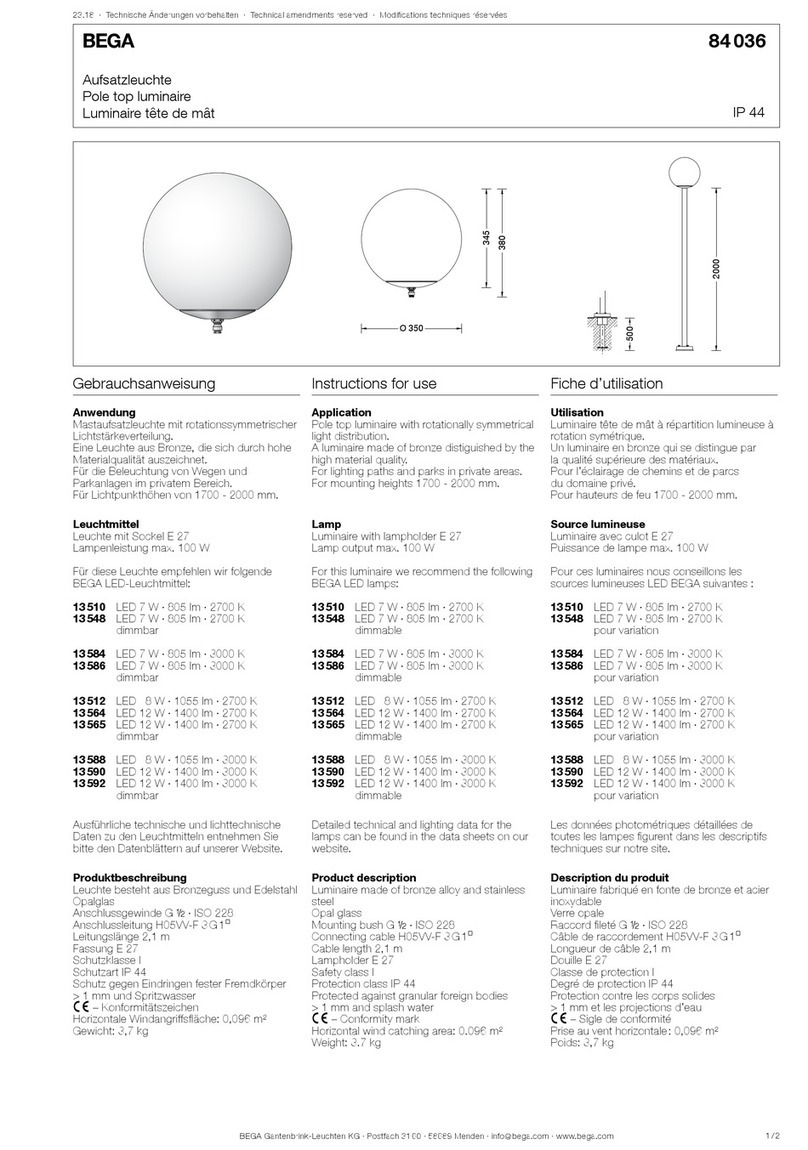
BEGA
BEGA 84 036 Instructions for use
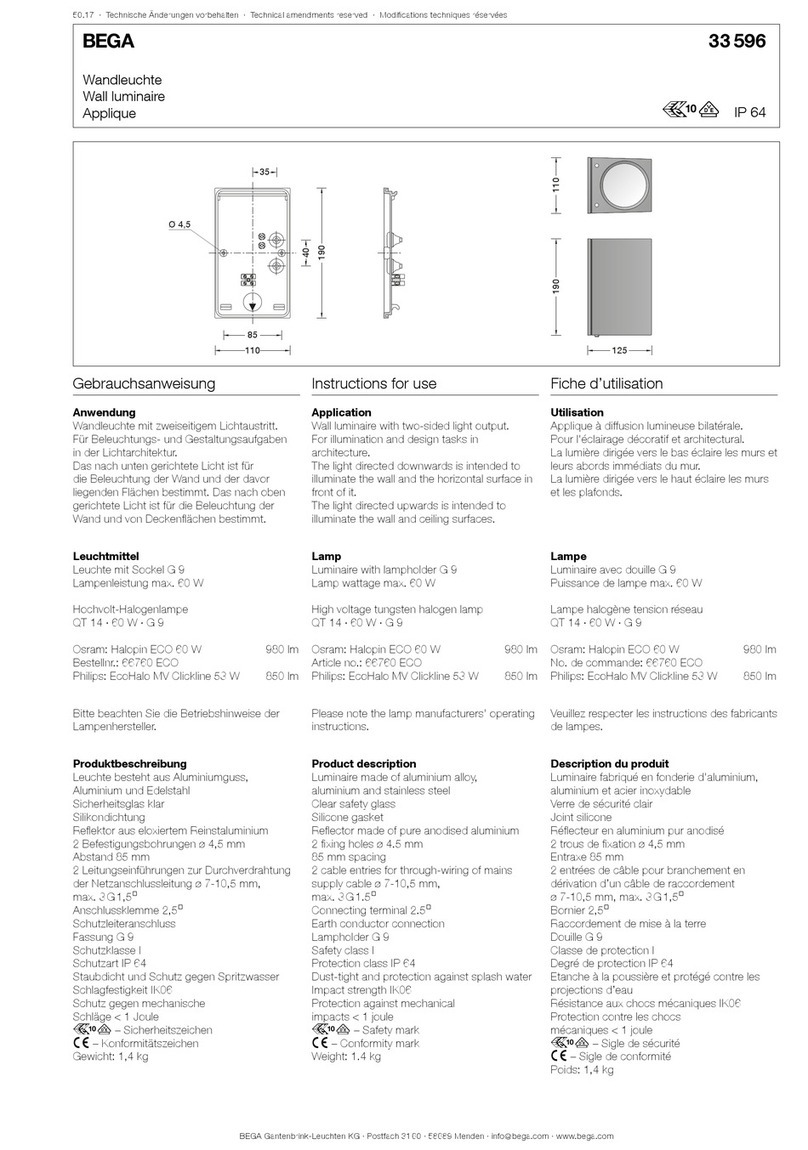
BEGA
BEGA 33 596 Instructions for use

Dale Tiffany
Dale Tiffany GT701162 Assembly instructions
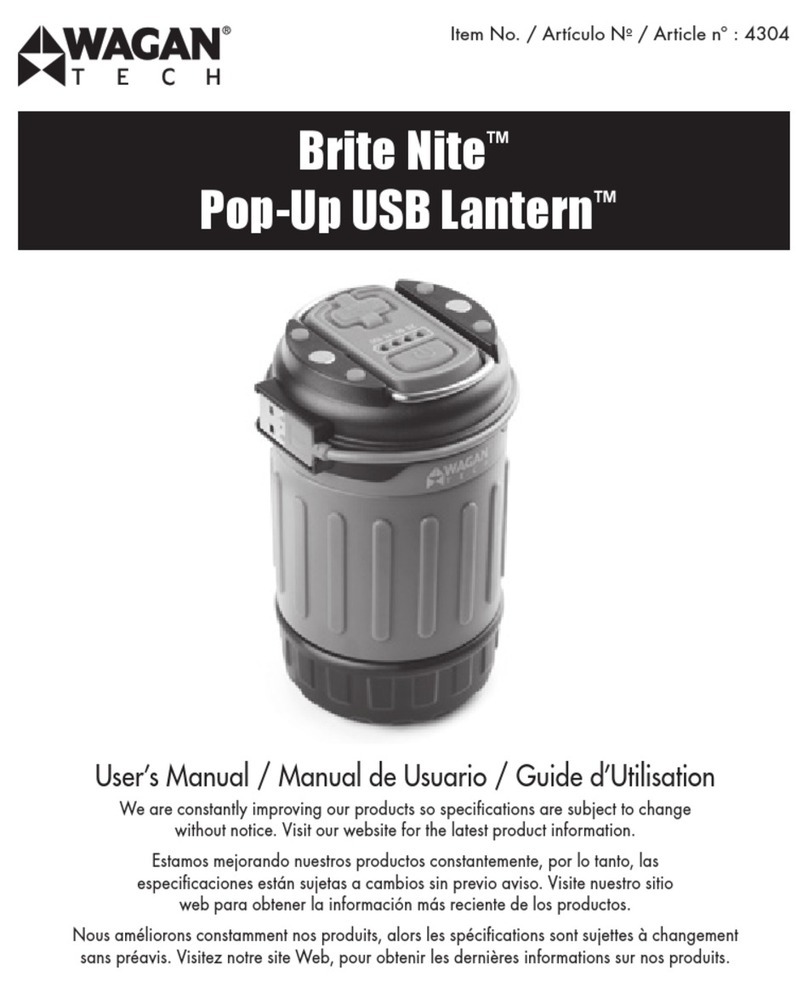
Wagan
Wagan Brite Nite Pop-Up USB Lantern user manual
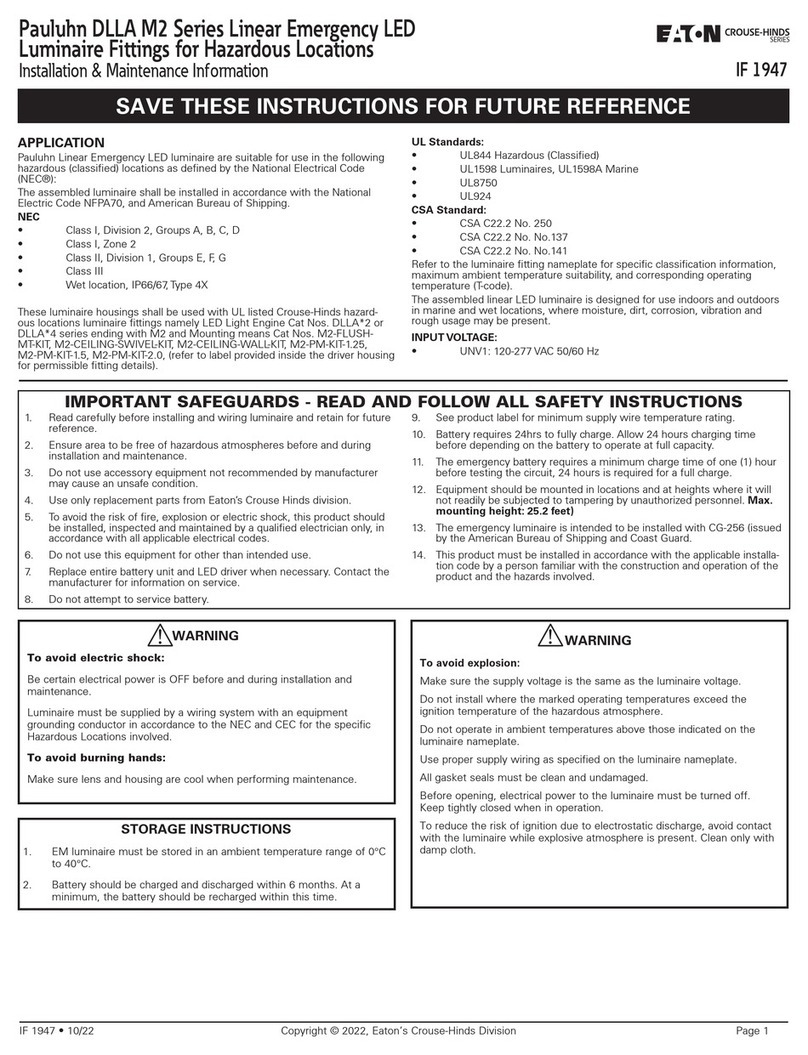
Eaton
Eaton Crouse-Hinds Pauluhn DLLA M2 Series Installation & maintenance information
